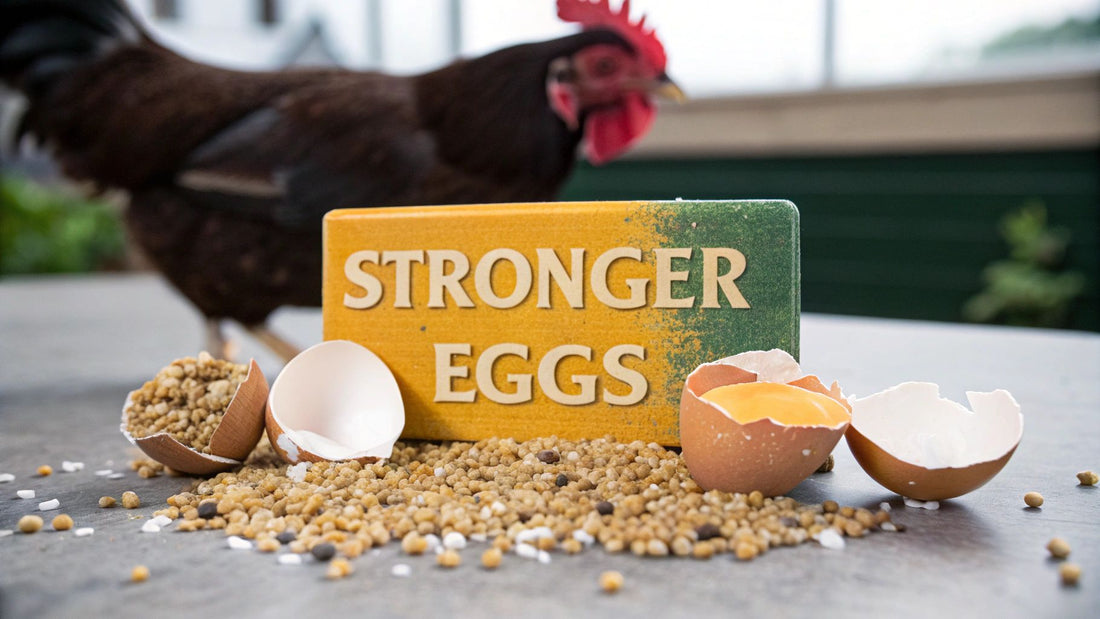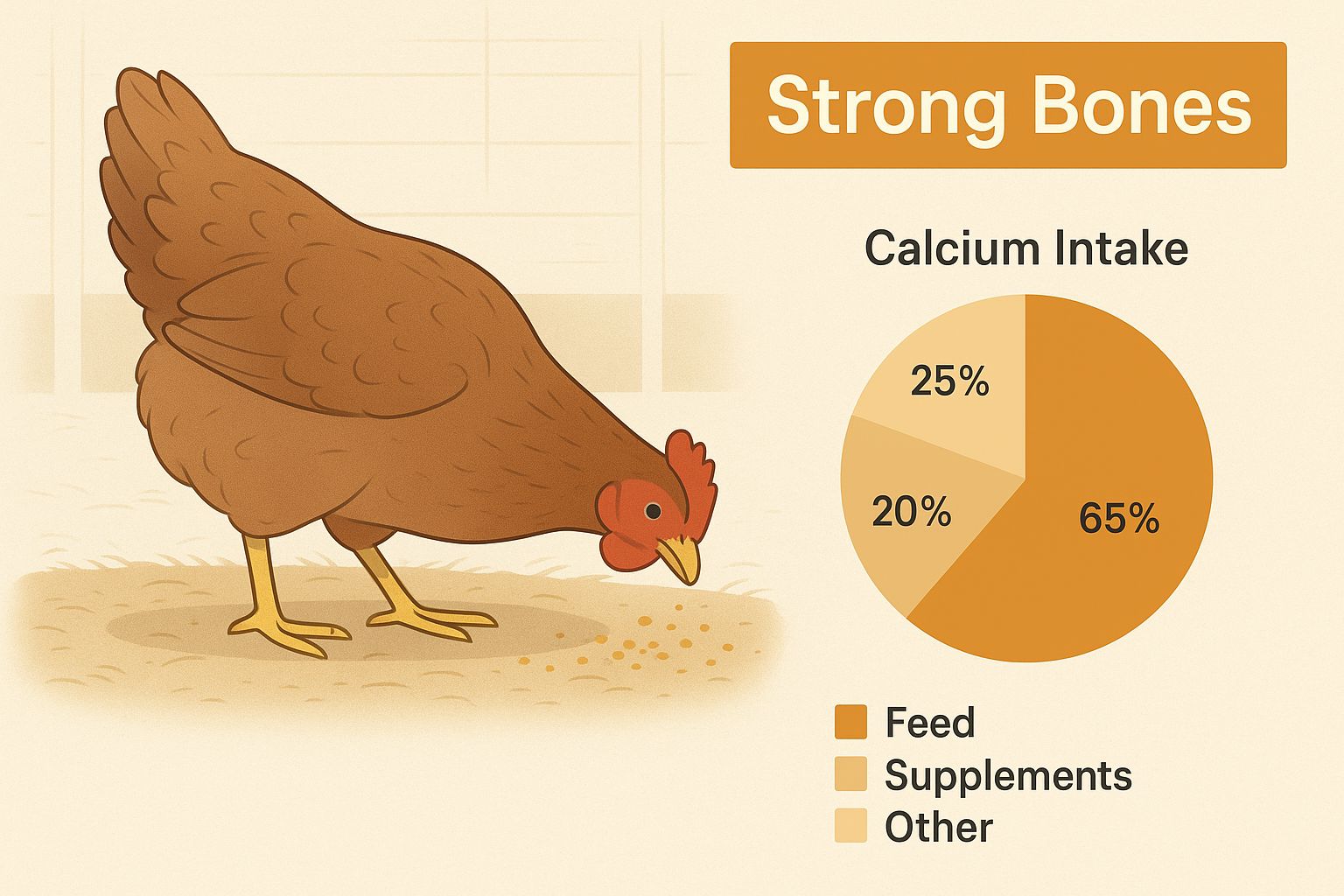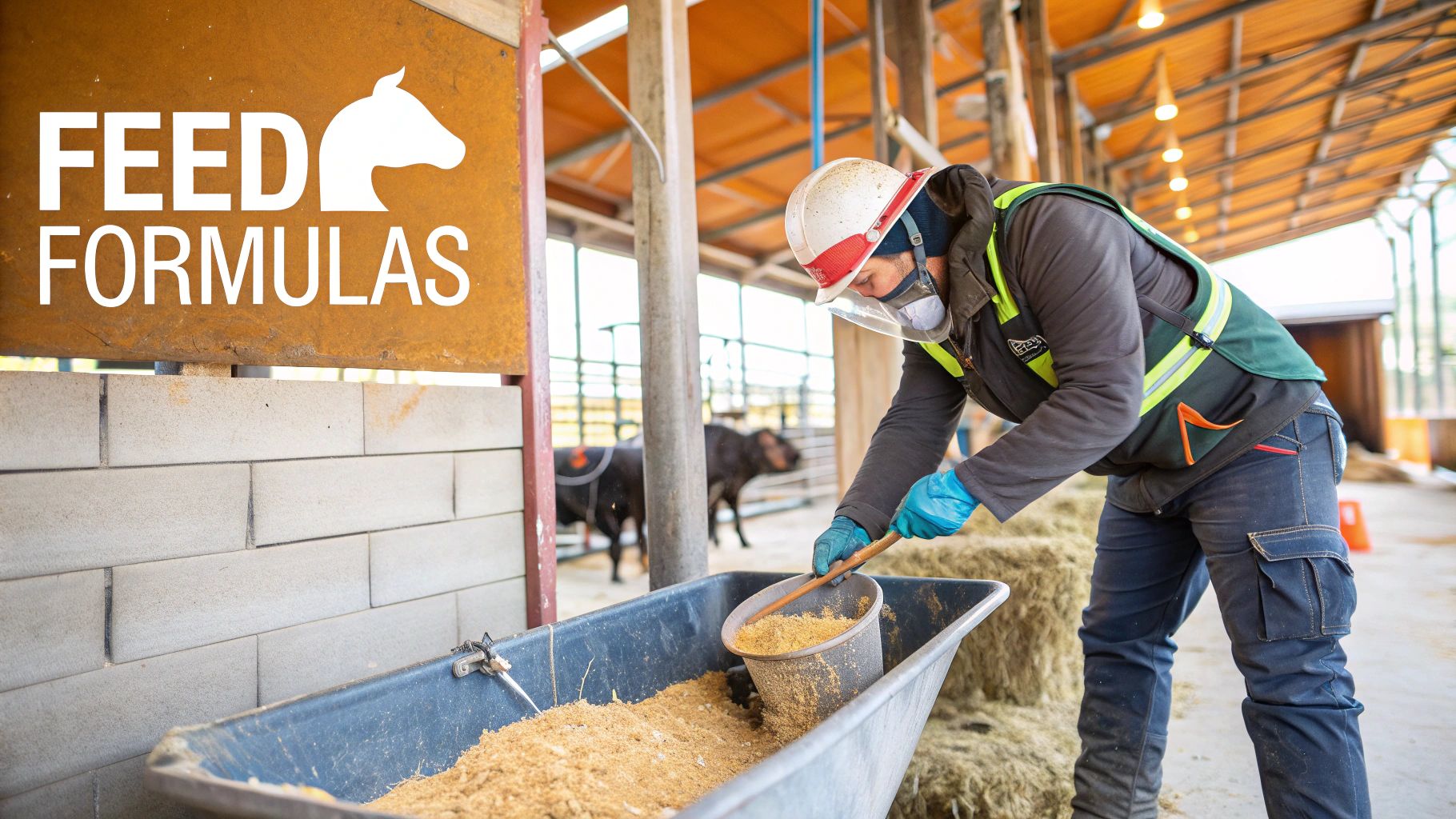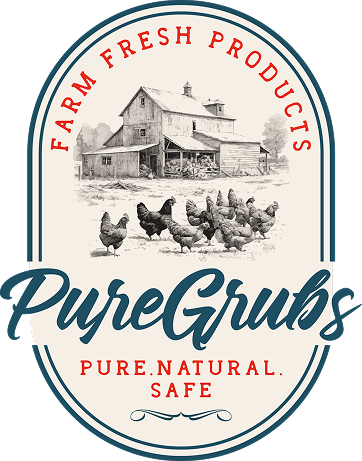
High Calcium Chicken Feed for Stronger Eggs & Hens
Share
When you've got a flock of laying hens, their diet is everything. High-calcium feed isn't just a "nice to have"—it's a critical part of keeping them healthy and productive. Think of it as the fuel they need to keep the egg factory running smoothly, ensuring they can produce strong eggs day after day without running their own bodies into the ground.
The Calcium Bank: Why Your Laying Hens Need Special Feed
Picture a laying hen's body like a calcium bank account. Every single egg she lays is a major withdrawal. In fact, it takes about 2 grams of pure calcium just to form one strong eggshell. If her daily feed isn't depositing enough calcium back into that account, she has no choice but to pull it from the only other source she has: her own bones.
As you can imagine, that's not a sustainable business model. Making these withdrawals day in and day out, without replenishing the supply, quickly leads to a serious nutritional deficit. Before long, her "calcium bank" runs dangerously low, and the fallout affects both her eggs and her own health in some pretty serious ways.
From Strong Shells to Healthy Skeletons
The first and most obvious sign you'll see from a good high-calcium diet is in the eggs. A hen with plenty of calcium lays eggs with tough, sturdy shells that can handle a bit of jostling in the nesting box or on the way to the kitchen. When she's not getting enough, the problems start showing up fast.
- Thin or Brittle Shells: You'll notice eggs that crack at the slightest touch.
- Soft or Shell-less Eggs: These are a sure-fire sign of a major calcium shortfall.
- A Drop in Egg Production: Sometimes, a hen’s body will just slow down or stop laying altogether to preserve what little calcium she has left.
But this is about more than just egg quality. That constant demand for calcium puts a tremendous strain on a hen's skeleton, which can lead to some painful and debilitating health issues down the road.
One of the most heartbreaking results of a long-term calcium deficiency is a condition called "cage layer fatigue." This is when a hen's bones become so porous and weak from calcium depletion that she can no longer stand, and can even suffer from spontaneous fractures.
This is exactly why a proper layer feed is a non-negotiable part of chicken keeping. It stops your hens from having to sacrifice their own skeletal health just to lay eggs. By giving them a steady, reliable source of calcium, you're making sure they have everything they need to be happy, healthy, and productive members of your flock for years to come.
Choosing the Right Calcium Source for Your Flock
Once you realize just how critical calcium is for your hens, the next question is obvious: what’s the best way to get it into their diet? It can feel like there are a million options out there, but it really boils down to two main approaches. You can either offer natural supplements on the side or go with a complete commercial layer feed.
Each path has its own pros and cons. The right choice for you will really depend on your flock’s needs, what you're willing to spend, and how hands-on you want to be. Let's walk through both options so you can figure out what makes the most sense for your coop.

As you can see, strong nutrition is the bedrock of a healthy, productive hen. It all starts with building those "Strong Bones," which is exactly what a high-calcium diet is designed to do.
Natural Calcium Supplements
Natural supplements are exactly what they sound like—sources of calcium that you offer separately from your flock's main feed. Think of it like a little "calcium bar" where they can go when they need a boost. This approach gives your hens the freedom to self-regulate; they’ll instinctively take what they need, when they need it.
Some of the most common go-to options are:
- Crushed Oyster Shell: This is a classic for a reason. It breaks down slowly in a hen's digestive system, providing a steady, timed-release source of calcium.
- Limestone (Poultry Grit): Another excellent choice, agricultural-grade limestone offers a potent punch of calcium carbonate.
The biggest win here is that the hen is in control. The downside? The responsibility is on you to keep that separate feeder stocked and to make sure you're offering a source your flock actually likes. If you want to explore this path further, we've put together a complete guide on the best calcium supplement for chickens.
Commercial Layer Feeds
The other route is to use a pre-mixed commercial layer feed. This is the "all-in-one" solution. These feeds are carefully formulated by animal nutritionists to provide everything a laying hen needs in one bag, taking all the guesswork out of it for you. They don't just contain calcium; they have the perfect balance of phosphorus and Vitamin D3, which are crucial for making sure that calcium actually gets absorbed and used properly.
The real beauty of a quality commercial feed is its consistency. You know that every single bite delivers the same balanced nutrition. This kind of reliability is key for maintaining strong egg production and overall flock health, which is why so many backyard chicken keepers swear by it.
Convenience is a massive plus. You don't have to juggle separate supplements because the 16-18% protein and all the necessary calcium are already mixed right in. This balanced, scientific approach is a big deal in the feed industry. In fact, the global market for feed phosphates—a key ingredient in making high-calcium feeds effective—is expected to grow from USD 2.79 billion in 2025 to USD 3.52 billion by 2030. That's a lot of demand for nutritionally complete feeds.
Comparing Calcium Sources for Laying Hens
So, which is better? A natural, free-choice supplement or a complete commercial feed? It’s not always a clear-cut answer, and many keepers even use a combination of both. This table breaks down the key differences to help you decide.
| Calcium Source | Form | Pros | Cons |
|---|---|---|---|
| Oyster Shell | Free-choice supplement | Allows hens to self-regulate intake; slow-release absorption. | Requires a separate feeder; must be kept consistently available. |
| Limestone | Free-choice supplement | High calcium concentration; widely available and affordable. | Can be dusty; hens might prefer oyster shell's texture. |
| Commercial Layer Feed | Complete, balanced ration | Nutritionally complete (includes phosphorus, Vitamin D3); highly convenient. | Hens can't adjust calcium intake; may be more expensive. |
Ultimately, the goal is the same: to provide your laying hens with the consistent, high-quality calcium they need for strong shells and strong bones. Whether you choose the self-serve style of natural supplements or the all-in-one convenience of a commercial feed, paying close attention to your flock's calcium intake is one of the most important things you can do as a chicken keeper.
The Critical Calcium and Phosphorus Partnership
Simply loading up your hen’s diet with calcium isn't enough. It's only half the story. For a hen to actually build those strong eggshells and maintain her own bone health, calcium needs a crucial partner to get the job done.
Think of it like a construction crew. Calcium is the pile of bricks, but without phosphorus—the mortar and the bricklayers—those bricks can't be put together to build anything useful. Phosphorus is the mineral that allows a hen’s body to properly absorb and use the calcium she eats.
Without enough phosphorus, all that valuable calcium can pass straight through her system, never making it to her bones or the shell gland. This delicate mineral balance is one of the biggest secrets to truly effective poultry nutrition. If the balance is off, you can end up with the same problems as a straight-up calcium deficiency, like weak shells and brittle bones.
Finding the Right Mineral Balance
So, what’s the magic number? The ideal ratio of calcium to phosphorus actually changes depending on a chicken’s age and whether she’s laying eggs. This is something commercial feed manufacturers spend a lot of time perfecting.
- For Pullets (Young Hens): Before they start laying, young hens need a ratio of about 2:1 (calcium to phosphorus). This supports their growing skeletons without putting too much strain on their developing kidneys.
- For Laying Hens: The moment a hen starts laying eggs, her calcium needs go through the roof. The ideal ratio in her feed needs to jump to at least 4:1 to keep up with the daily demand of forming an eggshell.
Getting this right is a big deal in the agricultural world. Feed grade phosphates, a primary source of phosphorus for commercial feeds, are a massive industry. The global market for these phosphates was valued at around USD 7.43 billion in 2024, a number that’s only expected to grow. You can dig deeper into the feed grade phosphate market on marketgrowthreports.com.
A proper calcium-to-phosphorus ratio is non-negotiable for a hen's long-term health. An imbalance stops calcium from being absorbed, leading to weak eggshells, brittle bones, and a drop in egg production—even if you think you're providing plenty of calcium.
Trying to nail this precise balance in a homemade feed mix can be tricky, which is why so many flock owners stick with professionally formulated layer feeds.
But you can also support this nutritional teamwork with smart, natural supplements. For example, some treats are naturally well-balanced. Learning how black soldier fly larvae for chickens provide a fantastic, naturally high-calcium treat with a healthy phosphorus profile can be a game-changer. This ensures your hens get the most out of every nutrient, leading to stronger shells and healthier, happier birds.
Alright, let's get into the nitty-gritty of what your hens actually need. It's one thing to know about high-calcium feed, but it's another thing entirely to get it right in your own coop. The real trick is giving your girls the right amount of calcium when they need it most.
A busy laying hen is an egg-laying machine, and that process takes a serious toll on her body. To create a strong, solid eggshell every day, she needs a reliable source of calcium—otherwise, she’ll start pulling it directly from her own bones.
So, what’s the magic number? A laying hen needs about 4 to 5 grams of calcium every single day. That might not sound like a lot, but for a chicken, it's a huge nutritional demand that her regular diet must consistently meet.

This is precisely why a good quality layer feed is non-negotiable. These specialized feeds are carefully formulated to contain between 3.5% and 4.5% calcium. This ensures that a hen eating her normal daily portion gets everything she needs to stay healthy and productive.
Letting Your Hens Decide
Here’s a little secret from seasoned chicken keepers: not every hen needs the exact same amount of calcium every single day. A pullet just gearing up to lay her first egg has different needs than a veteran hen in the prime of her laying cycle. That’s why a two-pronged approach works best.
Provide a complete layer feed as their main meal, but also offer a separate, free-choice feeder with a calcium supplement like crushed oyster shells or limestone.
This simple setup empowers your flock to self-regulate. Chickens are surprisingly intuitive; they know when they need an extra calcium top-up and will visit the supplemental feeder only when necessary. This is the perfect way to prevent them from getting too much calcium while making sure they never fall short.
Getting the Timing Right
When you introduce a high-calcium diet is just as crucial as what's in it. Switching your flock's feed at the right time sets them up for a long, healthy life of laying.
Here’s a simple timeline for your flock’s dietary journey:
- Starter Feed (0-6 weeks): This is all about protein to fuel that incredible, rapid growth of a baby chick.
- Grower Feed (6-18 weeks): The protein and calcium levels drop to support steady, healthy maturation without putting stress on their developing kidneys.
- Layer Feed (18+ weeks): It's time to bring in the high calcium chicken feed right before they're expected to start laying, which is usually around 18 to 20 weeks of age.
Keep an eye out for physical signs that they’re getting ready, like their combs and wattles turning a deeper red or when they start doing the characteristic "squat." Making the switch at this point ensures their bodies are primed and ready for the demands of egg production from the very first egg. It's also smart to remember that during a stressful molt or a summer heatwave, your hens might eat less, making that free-choice calcium source more important than ever.
Spotting and Solving a Calcium Deficiency
Even the most careful chicken keeper can run into a calcium deficiency. It happens. The key is knowing what to look for so you can step in quickly before it becomes a bigger problem. Your hens will absolutely tell you when something is wrong—you just have to learn their language.
The first place you'll usually see trouble is in the nesting box. A weird egg every once in a while is no big deal, but if you start seeing a consistent pattern of bad shells, that's a major red flag. It’s your flock's clearest signal that a hen is struggling to get enough calcium to build a proper eggshell.
Early Warning Signs of Deficiency
Catching the problem early is everything. It can save a hen from serious, long-term health issues. Pay close attention to both the eggs and the birds themselves.
- Thin or Brittle Shells: If eggs crack with the slightest touch, that's a classic sign.
- Soft-Shelled or Shell-Less Eggs: Finding a rubbery, membrane-encased egg means your hen is in a significant calcium deficit.
- Lethargy or Lameness: A hen that’s moving stiffly, seems tired, or starts limping might be pulling calcium from her own bones, making them weak and brittle.
- Egg Binding: This is a life-threatening emergency where a hen can’t pass an egg. It’s often caused by weak muscle contractions due to low calcium.
A Quick Action Plan for Correction
If you see any of these signs, don't wait. Acting fast can turn things around and get your hen back on her feet.
Think of this as nutritional first aid. The immediate goal is to give her a quick calcium boost, then figure out what went wrong with your long-term feeding plan to make sure it doesn't happen again.
First things first, get some extra calcium in front of her. Put out a separate dish of crushed oyster shell or agricultural limestone so she can eat as much as she needs. A few calcium-rich treats can also provide a fast-acting boost. At the same time, check the label on your main feed to confirm it’s a quality high calcium chicken feed with at least 3.5% calcium.
Finally, make sure your flock gets plenty of sunlight or a feed that contains Vitamin D3. Without it, they can't absorb the calcium they eat, no matter how much you provide. In commercial operations, dicalcium phosphate (DCP) is a go-to supplement to ensure both calcium and phosphorus are balanced for strong bones and peak production. The market for this single ingredient is expected to hit USD 2.5 billion by 2032, which just goes to show how critical these minerals are at a larger scale. You can find more details about the feed phosphate market on gminsights.com. Taking these simple steps should solve the deficiency and get your flock back to laying beautiful, healthy eggs.
Common Mistakes in High Calcium Feeding
Getting your flock's nutrition right is one of the most rewarding parts of raising chickens, but it's easy to get tripped up, even with the best intentions. A few common missteps with high-calcium feed can lead to some serious health issues, so let's walk through how to avoid them.
Honestly, one of the biggest errors I see is a simple case of mistaken identity. People assume that a good, high-quality layer feed is perfect for everyone in the coop. But it's actually a very specific nutritional formula, designed only for hens who are actively laying eggs.
Feeding the Wrong Birds
The most critical mistake is giving high-calcium chicken feed to birds that simply don't need it. Roosters and young pullets that haven't started laying yet have completely different calcium needs.
When they eat the high levels found in layer feed, their kidneys have to work overtime to get rid of all that excess calcium. Over time, this can lead to permanent kidney damage or a painful condition called gout.
- Roosters: Stick with a maintenance feed that has lower calcium and protein levels. They just don't need the extra minerals.
- Pullets: Young hens need a good grower feed until they're about 18 weeks old. This supports healthy bone development without overwhelming their still-developing systems.
The bottom line? Always make sure you're providing the right feed for the right bird based on their age and job in the flock.
Mismanaging Calcium Supplements
Another common pitfall is the way we offer extra calcium. Many backyard chicken keepers make the mistake of mixing crushed oyster shell or limestone directly into the main feed. It seems efficient, but it takes away a hen's ability to self-regulate.
A hen’s calcium needs can change from one day to the next, depending on her laying cycle. Forcing her to eat a fixed amount of calcium means she might get too much on one day and not enough on another.
The best practice? Always offer supplemental calcium in a separate, free-choice feeder. This simple step empowers each hen to take exactly what her body is telling her she needs, preventing both deficiencies and dangerous overdoses.
Finally, don't rely on kitchen scraps as a primary source of nutrition. While they're a fantastic treat, they just don't have the consistent, balanced profile your flock requires for long-term health. For some great ideas on treats that actually complement a balanced diet, check out our guide on dried grubs for chickens.
Steering clear of these simple mistakes will help ensure your feeding strategy keeps every single bird healthy and thriving.
Got Questions About High-Calcium Feed? We've Got Answers.
When it comes to feeding your flock, especially your laying hens, a lot of questions can pop up. Getting the details right on calcium is one of the most important things you can do for their health. Let's clear up some of the most common head-scratchers.
Can My Roosters and Chicks Eat Layer Feed?
That’s a hard no. It might seem convenient to feed everyone from the same bag, but high-calcium layer feed is a special diet designed only for egg-laying hens.
Giving it to roosters, chicks, or even young hens that aren't laying yet is a recipe for disaster. The excess calcium can overwhelm their systems, leading to serious, and often permanent, kidney damage or a painful condition called gout.
Stick to a feed that's right for their life stage:
- Chicks (0-6 weeks): They need a high-protein starter feed to fuel their rapid growth.
- Pullets (6-18 weeks): A grower feed provides balanced nutrition without the calcium overload.
- Roosters: A simple, lower-calcium maintenance feed is all they need to stay healthy.
When Should I Switch My Hens to Layer Feed?
The sweet spot for making the switch is right around 18 to 20 weeks of age, or just as you start seeing signs that the first egg is on its way. Look for clues that your pullets are maturing: their combs and wattles will deepen to a vibrant red, and you might catch them doing the characteristic "squat" when you approach.
Timing is everything here. Switching too early can strain their still-developing kidneys. But if you wait too long, they'll be forced to steal calcium from their own bones to form those first few eggs, which is a tough start to their laying career.
Are Crushed Eggshells a Good Source of Calcium?
They can be a decent supplement, but they shouldn't be your hens' only source of extra calcium. If you do use them, make sure they are completely cleaned, baked dry, and crushed into tiny, unrecognizable pieces. This is crucial to prevent your flock from developing a taste for fresh eggs right from the nest.
Think of eggshells as a handy recycled supplement, but not a complete solution. A better bet is offering free-choice crushed oyster shell or limestone. Their larger, gritty texture is designed to sit in the gizzard and dissolve slowly, providing a steady release of calcium exactly when a hen's body needs it to build a strong shell overnight.
Looking for a treat that does more than just taste good? Pure Grubs offer a natural calcium boost that supports strong eggshells without messing up your hens' balanced diet. Our USA-grown Black Soldier Fly Larvae pack up to 85% more calcium than mealworms, making them a healthy and delicious way to support your flock.
Check out our premium BSFL and give your girls a treat they'll love at the Pure Grubs shop.
Article created using Outrank
